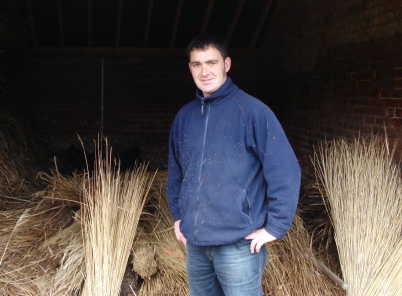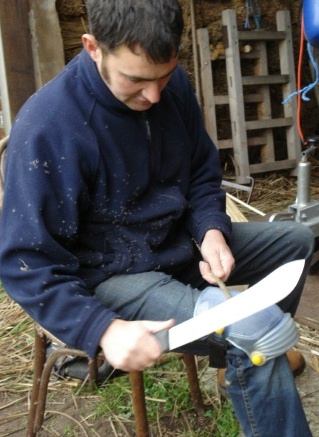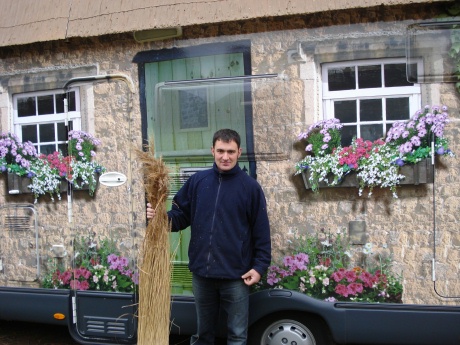A Day with a Norfolk Thatcher
Wednesday, October 24th, 2007
We’ve just spent the morning with Dameon Layt, a reed thatcher from Norfolk. Things didn’t go entirely to plan when the job he was supposed to be working on was put back a few weeks because they’d found bats in the roof, but he still kindly agreed to meet us at the barn (thatched, of course) where the bundles of Norfolk reed are stored, to explain a bit about what he does.

Dameon
As it turned out, Dameon completely opened our eyes to the modern-day thatching industry so, rose-tinted glasses firmly aside, here’s what we learnt:
How it’s done: roofs can be thatched with either straw or reed, but primarily reed in East Anglia as that’s where it mostly comes from. The reed is fastened together in bundles and secured, layer by layer, to the roof beam using a thatching iron. Next, a ‘leggett’ (the torturous-looking instrument in the photo below) is employed to keep the bottom, or ‘butt end’, of the reed in smooth alignment all the way up the roof.

Thatching Tools
Sedge (a pliable marsh grass) is then used to construct the ridge of the roof: unlike the reed, which snaps, the sedge is easier to bend. It is the sedge part of the roof which is often the most decorative, with different thatchers using ‘liggers’ (strips) and ‘brotches’ (staples) made of hazel to secure the sedge to the roof and create a signature patternwork ridge.

Dameon making a brotch by splitting a length of hazel, and sharpening and twisting it to form a staple. A ‘wet day job’, thatchers can make about 500 of these a day and typically use a couple of thousand to secure an average ridge.
The lifespan of the thatch is not only dependent on the skill of the thatcher, but also on other factors such as climate, the pitch of the roof (45 degree min.) and the quality of the reed. Whilst the sedge normally needs to be replaced every fifteen to twenty years, the actual reed should last between sixty and eighty (whilst straw only lasts about thirty).
Now this is what surprised us: with Emma living in a thatched cottage in Bedfordshire and sitting on what seems like a two-year waiting list to get her sedge repaired, we thought we were going to be writing about the declining thatching industry and the rarity that is a young thatcher such as Dameon. However, according to him (in Norfolk anyway), this is not the case. With large thatching companies taking over, and with an influx of cheaper labour from abroad, individual local thatchers are finding it hard to compete and what was once a traditional craft is now turning into big business. People want work on their houses done quickly and when you think that it would take an individual thatcher about two months to complete the roof of an average family home and a larger thatching business with, say, three men employed on the job at one time, just three weeks to do the same, you can see where the problem lies.
But big business isn’t really what drew Dameon to thatching in the first place and, whilst he is still passionate about the craft, he has decided to let it take a back seat whilst he concentrates on his prize-winning flock of Norfolk Horn sheep and develops his rare-breed lamb catering business. Available next year, if you would like more information about the Sallowes Flock and where he will be catering, you can contact him on 07721 710238.
And we almost forgot…
What did this professional thatcher think of our thatched roof?

Errr…hard to say!


